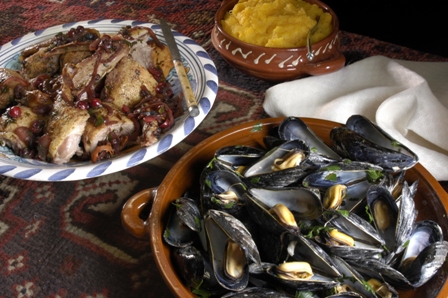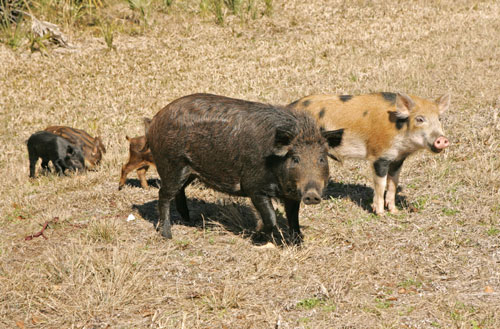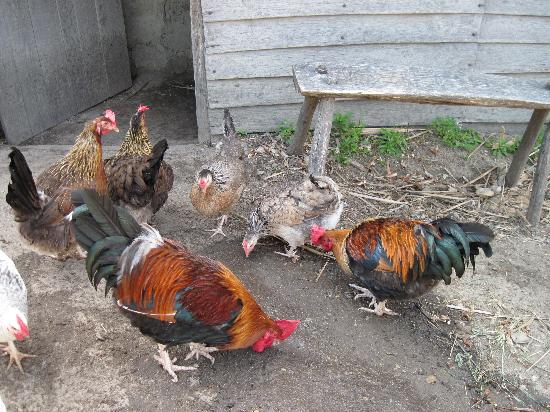The Pilgrims did not bring large animals with them on the Mayflower. So there were no cattle. Although chickens were not specifically mentioned, it seems likely they were on board. Mayflower passenger Edward Winslow gave chicken broth to the Wampanoag Sachem Massasoit when he was sick in early 1622. It is also likely they brought some pigs and goats. In 1623, Emmanual Altham visited Plymouth and reported there were six goats, fifty pigs, and many chickens.
As far as other food, recent historians Caleb Johnson, Simon Neal, and Jeremy Bangs started transcribing and studying a rare manuscript in the possession of the Massachusetts Society of Mayflower Descendants. The manuscript contains a list of suggested provisions the colonists should bring with them. It is the closest thing we can get to a list of what the Pilgrims would have actually brought. For food and drink it was recommended they bring biscuits, beer, salt, oats, peas, dried beef, salt pork, wheat, butter, sweet oil, mustard seed, ling or cod fish, "good cheese", vinegar, aqua-vitae, rice, bacon and cider.
With this in mind, our pilgrim recipes will include only those ingredients listed above. Aside from this, we will also use vegetables, fruits and herbs that were indigenous to the area in 1621.
Plimoth Plantation on Pilgrim Food
How would you like to live in a time when children drank beer but didn't drink milk? A time when deer and swan were considered delicacies and lobster was everyday food? Welcome to England and New England in the 1600s!
Though the English from this time ate some of the same foods that we do today, their diet was quite different from ours. In fact, people back then had a very different idea of what foods were good for them. To their minds, bread, beer and meat were the best foods, although they couldn't often have them in New Plymouth.
In the 1600s everyone ate according to the season. Back then many foods were available only at certain times of the year. No matter how much money you had, there were some foods that you just couldn't have. Without refrigeration and the fast shipping that we have today, foods couldn't be brought in from other parts of the world before they spoiled. So, it was impossible to have fresh strawberries in December.
After the colonists first arrived in Plymouth, they had three really difficult years. There were no food shops in New England, so the colonists had to produce their own food. They struggled to grow crops in a climate that was different from England. Fishing was difficult because most of the colonists weren't trained as fisherman and they brought the wrong sized fish hooks! Supplies from England didn't come as frequently as they wished, so whole years went by without any imported goods like sugar and butter.

Things did improve, though. The colonists got better at fishing. They began to grow more Indian corn, which they learned to cultivate from the Wampanoag People. And they learned the best ways to hunt and trap animals such as deer, rabbit, turkey, geese, duck, and other wildfowl. The domesticated animals that they brought from England -- chickens, goats, sheep and cows -- were increasing in number and were able to be eaten. And supplies such as sugar, spices, oil, vinegar and wine began to be sent over on ships yearly. Some colonists wrote letters back to friends and family saying how good their diet had become -- better than when they lived in England or Holland.
The one thing they still missed, though, was beer. In England, beer was the preferred drink for the whole family, even children. Though it is possible that some families in Plymouth brewed a small amount of beer from barley, most families had to make do with drinking water. Oddly enough, water was considered downright unhealthy to drink! Some colonists were surprised that their children were so healthy when they drank water instead of beer. Milk was not considered very good to drink either. It was usually made into butter or cheese, or cooked with to make tasty grain porridges.
Just like us today, the Pilgrims usually ate three meals a day. But how they ate these meals is a little different. Many people would “break fast” in the morning with a little bread and butter, or cheese, or something left from the day before. In the middle of the day, everyone ate dinner, which was a largest meal of the day made up of several foods. There was probably a thick porridge or bread made from Indian corn and some kind of meat, fowl or fish. Supper was a smaller meal, often just leftovers from dinner.
From:  http://www.plimoth.org/learn/just-kids/homework-help/whats-dinner
http://www.plimoth.org/learn/just-kids/homework-help/whats-dinner
![]()
Planting
The colonists at Plymouth called their town a “plantation,” a word that comes from the word “plant.” Farming was a major part of the Pilgrims’ lives. They grew crops in large open fields. Women planted and tended vegetables and herbs in small gardens behind their houses. Because many of them had come from cities or towns in England with markets, many of the colonists had never farmed or gardened before coming to Plymouth. They were learning to feed themselves.
In the minds of English people, the perfect diet was one of meat or fish, bread or grain-based porridges, and beer. Dairy products and vegetables were eaten but were not considered essential for health. In England, however, only wealthy people could afford to eat in this way. Poorer families ate meals of vegetables, dairy products and, when they could afford them, meat. Since hunting and trapping were the privileges of landowners, wildfowl (like turkeys) and game (like deer) were not a major part of the common person’s diet.
In Plymouth Colony, however, the colonists’ diet was more varied. In New England, supplies of fish and shellfish were plentiful. Without hunting restrictions, deer, wild fowl, rabbits and other small animals were available to anyone who wanted to hunt them. The Pilgrims also brought farm animals with them, including pigs, chickens, goats, and later, sheep and cows. These animals provided meat, eggs and dairy products for the colonists.
Families in Plymouth planted enough in their fields to feed themselves. Their main crop was a kind of corn they had never seen before. Because it was native to North America and grew better in America than English grains, the Pilgrims called it “Indian corn.” The Wampanoag taught the English colonists how to plant and care for this crop. First, they had to clear the land. They chopped down trees and pulled up grass and weeds. They dug holes in the ground and put two or three herring (a type of fish) in the hole and covered them with dirt. The herring fertilized the soil to make it good for growing corn. They planted 4-5 corn seeds in every mound. All of this work had to be done with hand tools – tractors and automatic machines hadn’t been invented yet.
Indian corn was different from the sweet yellow corn that we eat today. It had various colors – reds, blacks, yellows and whites – on the same ear, and was not eaten fresh from the cob. Instead, Indian corn was dried and then pounded into flour and cornmeal for cooking and baking. Indian corn was part of almost every meal in Plymouth Colony.
Along with Indian corn, the Pilgrims also grew some beans, pumpkins, wheat, barley, oats and peas in their fields. In the gardens near their houses, women grew many different kinds of herbs and vegetables, like parsley, lettuce, spinach, carrots and turnips. Some foods, like salt, sugar, oil and vinegar, had to be imported from England.
The combination of available meat and shellfish, Indian corn and other field crops and garden plants made the Pilgrims’ diet a rich and varied one through most seasons of the year. Like the Wampanoag, however, the colonists experienced seasonal variations. Not all foods were available at every season of the year. The Pilgrims tried to extend the life of their foods through preservation. Salting, the most common method of preservation, worked well for pork (meat from pigs) and fish. This method was sometimes combined with smoking for meats. Drying was also common. Vinegar pickles and sugar were also occasionally used to preserve foods.
As the years passed, the Pilgrims began to grow more food than they needed to eat. The colonists traded their extra Indian corn with Native People to get furs. The furs were then sent back to England to be sold. The money they made from selling furs was used to buy many of the goods they imported from England. Farming was not just a way to eat, then, but also a way to get goods that they could trade for sugar, spices, oil, vinegar, clothes, shoes, baskets and gunpowder.
Their lives depended on a good harvest.
Source:  http://www.plimoth.org/learn/just-kids/homework-help/growing-food
http://www.plimoth.org/learn/just-kids/homework-help/growing-food
![]()
Pilgrims brought Pigs, Chickens and Goats
 Historians state that it is likely pigs arrived at Plymouth on the Mayflower. But the were trouble as soon as they arrived. The pigs were turned loose as a living cache of food for settlers to hunt as needed. The pigs frequently raided the corn caches of the Wampanaog and other local Indians causing much trouble between the Pilgrims and Native populations. These pigs were not the pigs we are familiar with today. These pigs are called feral pigs, wild hogs, and razorbacks.
Historians state that it is likely pigs arrived at Plymouth on the Mayflower. But the were trouble as soon as they arrived. The pigs were turned loose as a living cache of food for settlers to hunt as needed. The pigs frequently raided the corn caches of the Wampanaog and other local Indians causing much trouble between the Pilgrims and Native populations. These pigs were not the pigs we are familiar with today. These pigs are called feral pigs, wild hogs, and razorbacks.
 Chickens were very common in early Plymouth and quite probably were brought on the Mayflower since Mayflower passenger Edward Winslow gave chicken broth to the Wampanaoag Sachem Massasoit when he was sick in early 1922. It is probable that the Dorking breed of chicken were the chickens brought on the Mayflower. They are a historic breed that originated from the home parish of Mayflower passengers William Mullins and Peter Browne.
Chickens were very common in early Plymouth and quite probably were brought on the Mayflower since Mayflower passenger Edward Winslow gave chicken broth to the Wampanaoag Sachem Massasoit when he was sick in early 1922. It is probable that the Dorking breed of chicken were the chickens brought on the Mayflower. They are a historic breed that originated from the home parish of Mayflower passengers William Mullins and Peter Browne.

Goats probably arrived on the Mayflower. In 1923, Emmanual Altham visited Plymouth and state there were already six goats, fifty pigs and many chickens. The breed of goat that would have been on the Mayflower is the Old English Milch goat which is now extinct. Although, when Plimoth Plantation tried to find a goat which closely resembled the original, they found a descendent of the English Milch goat in New Zealand called the Arapawa Island goat. This is the goat they currently breed at Plimoth Plantation.
Livestock that came later
The first cattle arrived at Plymouth on the ship Anne in 1623, and more arrived on the ship Jacob in 1624. On board the Anne in 1623 were three cows, nicknamed the "Great Black Cow", the "Lesser Black Cow", and the "Great White-Backed Cow". On board the Jacob in 1624 were four black heifers (a heifer is a young female cow that has not yet had a calf.) The four black heifers were nicknamed "Least", "Raghorn", "Blind", and "Smooth-Horned". There was also a "Red Cow" that belonged to the poor of the colony. The black cattle were Kerry cattle a rare breed of dairy cattle native to Ireland. They are believed to be one of the oldest breeds in Europe. The "Red Cow" was probably a red Milking Devon cow.
The exact arrival of the first sheep in the colony is uncertain, but in January 1628 the Plymouth Court recorded that Myles Standish purchased from Abraham Pierce two shares of the "Red Cow" in exchange for two lambs. And probate estate inventories for three Mayflower passengers made in 1633 (Samuel Fuller, Francis Eaton, and Peter Browne) show that all three men owned several rams, sheep, and lambs. The breed of sheep would probably have been the Wiltshire Horn sheep.